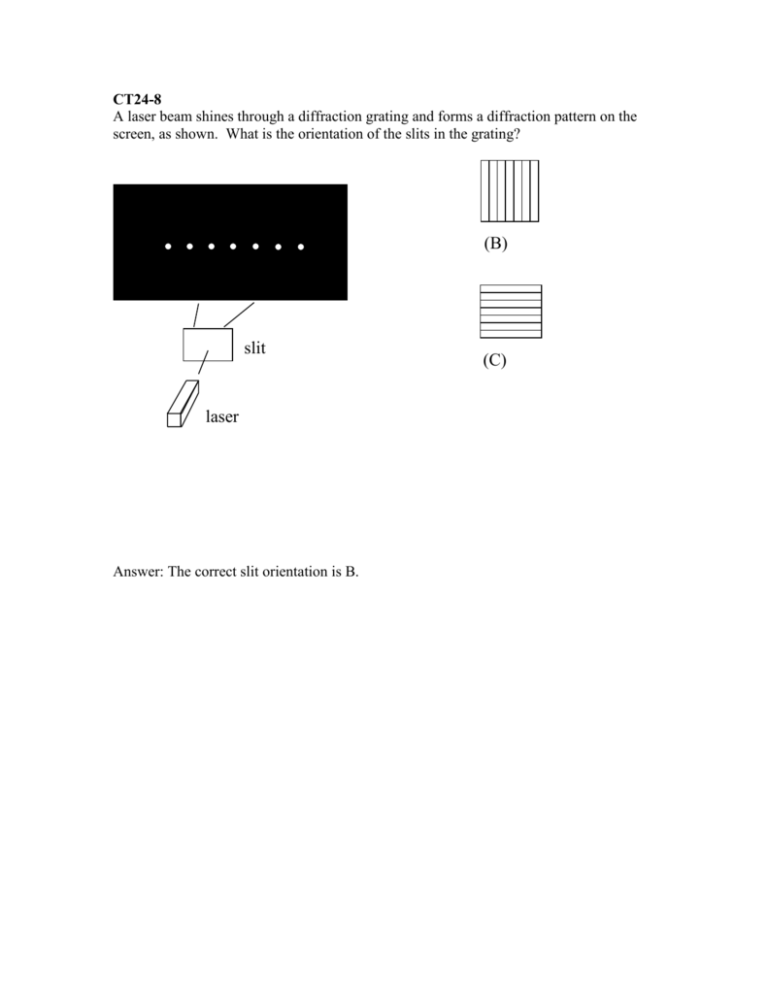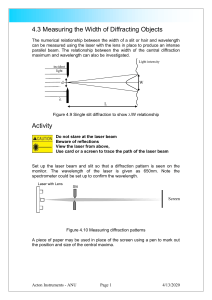Ch24CTc
advertisement

CT24-8 A laser beam shines through a diffraction grating and forms a diffraction pattern on the screen, as shown. What is the orientation of the slits in the grating? (B) slit laser Answer: The correct slit orientation is B. (C) CT24-9 A laser beam shines through a single rectangular slit which has an aspect ratio of 3 to 1, and the pattern below is seen on the screen. The laser beam covers the entire slit, as shown. What is the orientation of the slit? (B) (C) slit laser Answer: B. The relation between the slit width D and the angular width on the screen is . When D is large, is small and vice-versa. Along the horizontal direction D on the screen, is large, so D along the horizontal direction must be small. Here is a more complete explanation: In the case where one single vertical slit is hit with a laser beam, the situation is as shown below, left. Note that the laser beam is very wide (a few mm's) compared to the slit width (typically, D = 0.05mm). With this one vertical slit illuminated by a broad beam, there is diffraction in the horizontal direction producing a wide central max . But because the beam is so broad that there is negligible D spreading in the vertical direction (big D means small ). The rectangular hole can be considered to be the result of 2 crossed slits as shown below right. Now there is broadening in both horizontal and vertical directions, because the slit is narrow in both the x- and y- directions. slit slit D1 D D2 slit laser beam laser beam Pattern on screen with 1 vertical slit: much horizontal broadening due to small D, but almost no vertical broadening due to large laser beam diameter. Pattern seen on screen with 2 slits forming a rectangular hole: horizontal broadening due to small D1, but even more vertical broadening due to smaller D2. CT24-10 A laser shines through a double slit aperture and a 2-slit interference pattern is observed on a screen. The room is then filled with water and the experiment is repeated (the laser is water-proof). The separation of intensity maxima on the screen... B) increases C) decreases D) stays the same. Hint: wave speed v = f and the frequency of light remains constant as light passes from one medium to another. ?Answer: D), frequency and wavelength remain constant. CT24-11 A wedge-shaped air space is formed between two flat slabs of glass. The glass has index of refraction n. The reflected light of wavelength forms an interference pattern. What is the condition for a bright fringe? 2d = m θ d B) 2d sin = m C) 2d = (m + ½) x D) 2d sin = (m + ½) E) None of these/don't know XXX ?Answer: B) CT24-12 The path difference between the waves coming from two coherent sources to a point on a detector is 4.5 wavelengths. What is the phase difference in radians? B) 9 C) 18 D) 4.5 E) None of these Answer: 9 rads. 2 rads = 1 wavelength Q24-13 A polarized beam of light passes through a series of three ideal polaroid filters. The axes are at 0o, 45o, and 90o with respect to the direction of the Efield of the initial beam, as shown. Does any light get through the all the filters and come out the other side? E c B) Some light gets through. Answer: B). C) No light gets through. Q24-14 An unpolarized beam of light of intensity Io passes through two ideal polaroid filters. The axes of the two filters are at 45o with respect to each other. What is the intensity of the light which comes out of the last filter? E c I0 Hint: cos(45o) = B) D) 1 Io 4 1 Io 2 C) 1 2 1 2 2 Io E) None of these XXX Answer: E) None of these . (1/√2)Io Q24-15 A polarized beam of light passes through a series of ideal polaroid filters, whose axes are vary continuously from along the E-field of the original beam to perpendicular to the E-field direction, as shown. Does any light get through the all the filters and come out the other side? B) Some light gets through. E c Answer: B). C) No light gets through.







